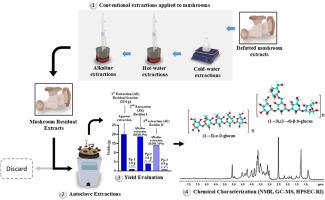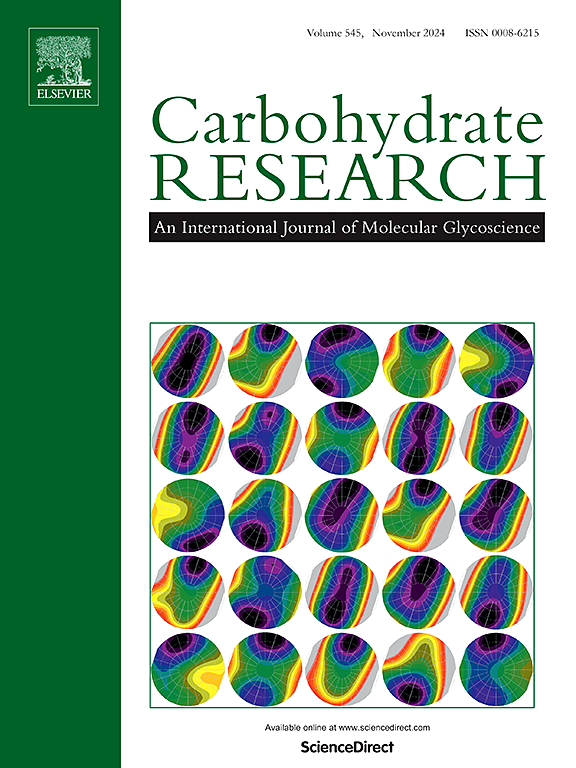高压灭菌法提取残蘑菇生物量:一种高效提取多糖的方法。
IF 2.5
3区 化学
Q3 BIOCHEMISTRY & MOLECULAR BIOLOGY
引用次数: 0
摘要
蘑菇来源的多糖,特别是β- d -葡聚糖,因其生物活性和广泛的生物技术应用而受到重视。虽然已经建立了几种传统的提取方法(冷水、热水和碱性),但经过彻底处理后剩下的生物质往往被丢弃,尽管它可能保留有价值的化合物。在这项研究中,我们通过在水、5% KOH和20% KOH条件下的顺序高压灭菌法提取,评估了从肺侧耳菌(Pleurotus pulmonarius)、菲洛塔(Pholiota nameko)和毒伞菌(Amanita muscaria)中提取的残留实验材料是否仍含有可提取的多糖。提取液用乙醇沉淀,定量,并通过NMR, GC-MS, HPSEC-RI,总糖和蛋白质测定进行表征。获得了显著的产量,特别是在5% KOH的情况下,单步产量高达31.1%,尽管蛋白质含量相当高。在整个提取步骤中,观察到分子量逐渐减少,单糖分析表明提取物主要由葡萄糖组成。结构表征证实了(1→3)-和(1→6)-键的β- d -葡聚糖、(1→3)-和(1→4)-键的α- d -葡聚糖以及半乳聚糖和甘露聚糖的优势。总之,这些发现表明,高压灭菌法是一种简单、高效、可扩展的方法,可以从蘑菇残留物中回收结构多样的多糖,从而提高资源利用率,并为真菌生物量增值开辟新的机会。本文章由计算机程序翻译,如有差异,请以英文原文为准。

Autoclave extraction applied to residual mushroom biomass: An efficient method for high-yield polysaccharide recovery
Mushroom-derived polysaccharides, particularly β-D-glucans, are valued for their biological activities and broad biotechnological applications. Although several conventional extraction methods have been established (cold-water, hot-water, and alkaline), the biomass that remains after exhaustive treatments is often discarded, despite its potential to retain valuable compounds. In this study, we evaluated whether residual laboratory materials from Pleurotus pulmonarius, Pholiota nameko, and Amanita muscaria still contain extractable polysaccharides by applying sequential autoclave extractions under aqueous, 5 % KOH, and 20 % KOH conditions. The extracts were precipitated with ethanol, quantified, and characterized by NMR, GC-MS, HPSEC-RI, and by total sugar and protein determinations. Significant yields were obtained, particularly with 5 % KOH, which produced up to 31.1 % in a single step, albeit with considerable protein content. Across extraction steps, a progressive decrease in molecular weight was observed, and monosaccharide analysis revealed that the extracts were composed predominantly of glucose. Structural characterization confirmed a predominance of β-D-glucans with (1→3)- and (1→6)-linkages, together with α-D-glucans with (1→3)- and (1→4)-linkages, as well as galactans and mannans. Overall, these findings demonstrate that autoclave extraction is a simple, efficient, and scalable approach to recover structurally diverse polysaccharides from mushroom residues, thereby enhancing resource utilization and opening new opportunities for fungal biomass valorization.
求助全文
通过发布文献求助,成功后即可免费获取论文全文。
去求助
来源期刊

Carbohydrate Research
化学-生化与分子生物学
CiteScore
5.00
自引率
3.20%
发文量
183
审稿时长
3.6 weeks
期刊介绍:
Carbohydrate Research publishes reports of original research in the following areas of carbohydrate science: action of enzymes, analytical chemistry, biochemistry (biosynthesis, degradation, structural and functional biochemistry, conformation, molecular recognition, enzyme mechanisms, carbohydrate-processing enzymes, including glycosidases and glycosyltransferases), chemical synthesis, isolation of natural products, physicochemical studies, reactions and their mechanisms, the study of structures and stereochemistry, and technological aspects.
Papers on polysaccharides should have a "molecular" component; that is a paper on new or modified polysaccharides should include structural information and characterization in addition to the usual studies of rheological properties and the like. A paper on a new, naturally occurring polysaccharide should include structural information, defining monosaccharide components and linkage sequence.
Papers devoted wholly or partly to X-ray crystallographic studies, or to computational aspects (molecular mechanics or molecular orbital calculations, simulations via molecular dynamics), will be considered if they meet certain criteria. For computational papers the requirements are that the methods used be specified in sufficient detail to permit replication of the results, and that the conclusions be shown to have relevance to experimental observations - the authors'' own data or data from the literature. Specific directions for the presentation of X-ray data are given below under Results and "discussion".
 求助内容:
求助内容: 应助结果提醒方式:
应助结果提醒方式:


